8 OVERSTACK OF THE RACK
Investigating the impact of bike rack overcrowding

21840 McClellan Rd, Cupertino, CA 95014 elestoque.org mv.el.estoque@gmail.com

Investigating the impact of bike rack overcrowding

21840 McClellan Rd, Cupertino, CA 95014 elestoque.org mv.el.estoque@gmail.com
Editors-in-Chief: Krish Dev, Anna Jerolimov
Managing Editors: Melody Cui, Gauri Manoj, Kripa Mayureshwar, Mira Wagner
Design Editors: Mikaylah Du, Sophia Ma
Graphics Editor: Sonia Verma
Copy Editors: Crystal Cheng, Minjae Kang, April Wang News Editors: Lillian Wang, Angela Zhang
Feature Editors: Taryn Lam, Aashna Patel, Irene Tang
Opinion Editors: Meggie Chen, Tvisha Gupta, Sarah Liu, Jisha Rajala


Entertainment Editors: Nameek Chowdhury, Jiya Singh, Aashi Venkat
Sports Editors: Kalyani Puthenpurayil, Michelle Zheng
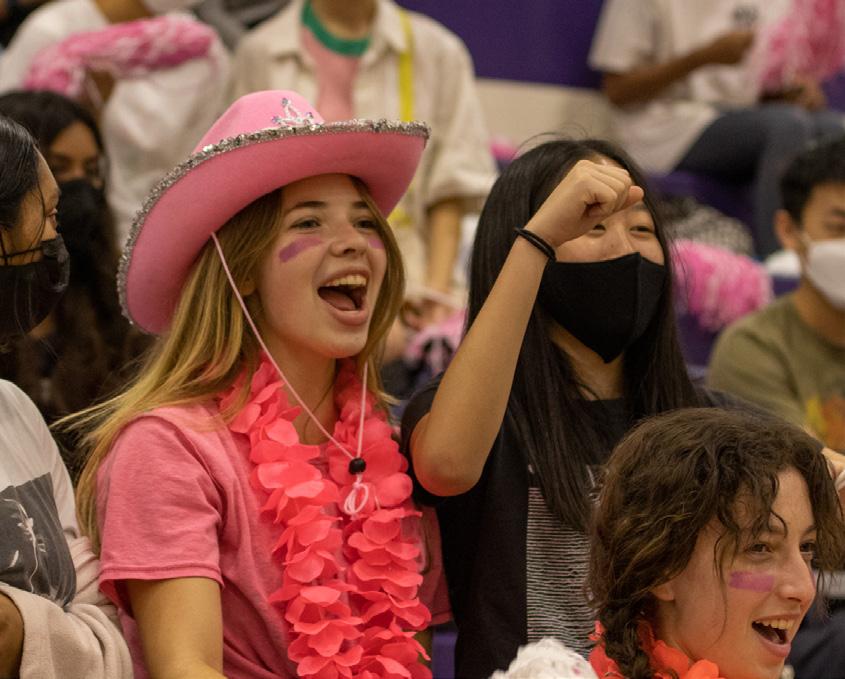
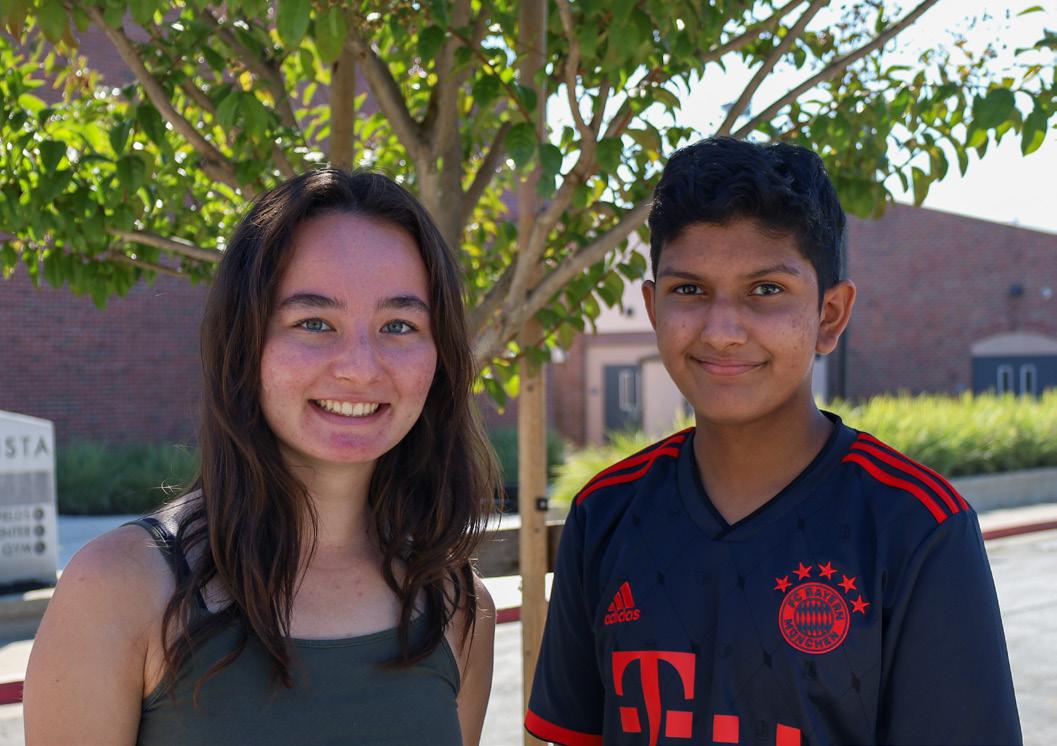
Staff Writers:
Chiran Arumugam, Anika Bhandarkar, Samika Bhatkar, Kathryn Foo, Pranati Kotamraju, Jami Lim, Megha Mummaneni, Riya Murthy, Aidan Ruan, Trisha Sannappanavar, Dahlia Schilling, Darpan Singh, Alan Tai, Mihir Vishwarupe, Anabelle Walker, Brandon Xu, Alyssa Yang, Stephanie Zhang, Vincent Zhao, Eric Zhou Adviser: Julia Satterthwaite, MJE
Mission Statement:
El Estoque will accurately inform our community through well-researched, unbiased and in-depth accounts of the student body and staff, news and developments and taboo topics prevalent in and near MVHS. Investigating various voices and credible perspectives, we hope to foster active discussion, effect positive change and spread awareness of timely, relevant content. As a trustworthy and reliable source of information, we strive to be accountable, adaptable and ready to correct and address our mistakes. Constantly striving for improvement, we will uphold integrity and ethics to be respectful and empathetic to our sources and our readers. We will exercise our press freedoms guaranteed by the First Amendment and California Ed Code 48907 while maintaining a community passionate about our work and journalism as a whole.
As kids, we first learned to walk, and then to run. We experienced persistence for the first time learning to bike without training wheels, our feet rising off the ground for longer and longer bursts of time, the bike giving us our first glance of freedom as we zoomed around the neighborhood.
Through it all, our parents chauffeured us to our various juvenile responsibilities in their cars, and we’ve recently received the new freedom of driving ourselves. But with the convenience of driving, we’ve lost some of the charm that being driven around used to bring — the sweetness of growing older is tinged with the sadness of inevitability.
Now, as seniors amid college applications, our decisions are instrumental in paving the path to impact not only the next four years but the rest of our lives. Yet, even with spending so much time thinking about the future, our vision doesn’t extend much beyond college. We spend so much time fixated on our vision of the perfect college that we don’t stop to consider what our adulthood might look like in a world where a healthy planet isn’t guaranteed.
And as we grew older, we became more aware of the effect that our actions have on our community. In our News package, we investigated the impact of all kinds of transportation, and reflected on the efforts of our community to better ourselves and our world through it. Bike racks are overcrowded, we’re improving walkability on Orange Avenue and California is working to eliminate the sale of gas-powered cars. Meanwhile, in Opinion, we examine the implications of these efforts more broadly. How much of an impact do our efforts truly have? How will it affect our future? And as we emerge into adulthood, what is our place in the world?
Growing up is inevitable, and it’s good for us to embrace it. However, in a world where nothing is guaranteed, we can’t forget the importance of living in the moment. Because although looking towards the future is important, we will only live in the present once: now.
Anna Jerolimov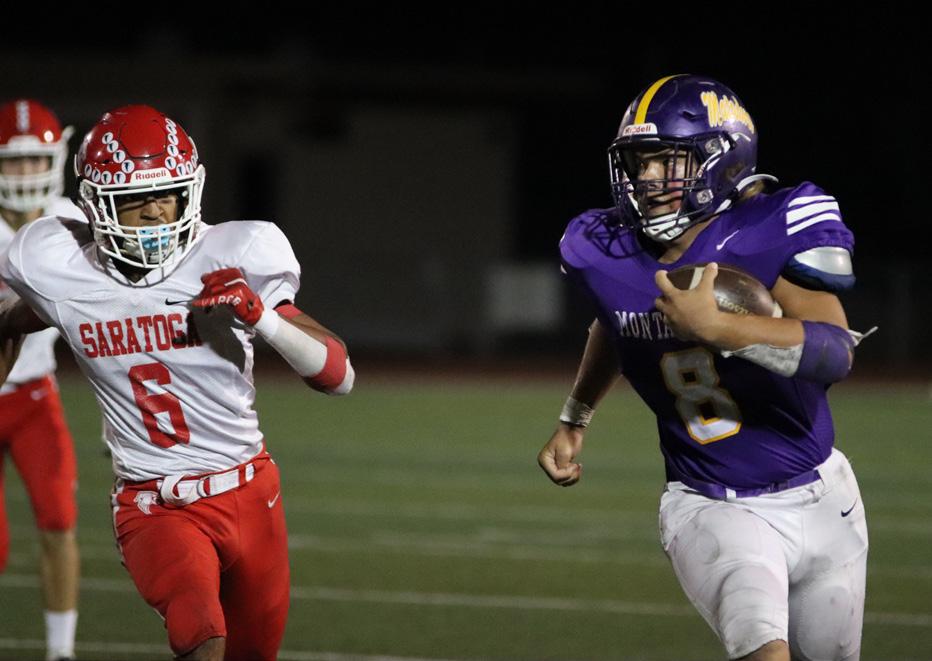



Cupertino and Santa Clara were awarded a state public transportation grant of nearly $8.5 million on July 7 to expand ViaCupertino, a public rideshare app, into Santa Clara and nearby destinations. The expanded service is expected to launch in April of 2023 and eventually to other cities, according to Cupertino Senior Transit and Transportation Manager Chris Corrao.

Corrao says Via is “carpooling with an app that the city subsidizes.” Because the city funds Via, they can offer low rates similar to those of public transit. Via launched its pilot program three years ago, and its service quickly gained momentum, with cities such as Sunnyvale, San Jose, Los Altos, Campbell, Mountain View and Los Gatos expressing interest in joining the service.
However, Via soon ran into an unexpected issue — the COVID-19 pandemic. After a temporary suspension due to health concerns, Via chose to resume service in October of 2021 to provide access to essential destinations such as supermarkets and health centers, despite plummeting ridership and increased costs. According to the Via Pilot Invoice Summary, the city subsidized an average of $182.59 per trip during October, compared to only $16.04 prior to the county COVID-19 stay at home order.
Despite that, Via has become more cost-efficient since its initial launch.
Via-Cupertino vans are wheelchair-accessible and have bike racks attached to the back.
In August, the average cost per trip was $39.02, much less than $79.68 in the first month of service, October of 2019. August saw the highest ridership since October 2021, one of the key performance indicators. Ultimately, Corrao believes that “all of these indicators are pointing to a big increase in ridership over the next year [with] the cost continuing to come down.”
The expansion will increase Via’s fleet from nine to 12 shuttles and create routes to additional essential destinations, such as the El Camino Hospital, requested by many senior citizens, and the Mountain View, Lawrence and Santa Clara Caltrain stations, for commuters. Corrao explains that
historically underserved communities benefit the most from Via due to its affordability and easy access.
“We’ve had people tell us anecdotally that it’s been life changing for them,” Corrao said. “Instead of waiting 20 minutes for a bus and a transfer, they’re able to quickly get to the rail station. And I think for seniors in Santa Clara that will now be getting the app for the first time, we will hear the same thing that we’ve been hearing from Cupertino seniors, which is that Via has given them a new sense of independence. I think we can anticipate to hear that from more communities as we continue to grow.”

As a student without a driver’s license, sophomore Siyona Kathuria has also found using Via allows a greater sense of independence. Before using Via, she was “completely dependent” on her parents, but having the ride-share service has made making plans with others “a lot easier.”
Kathuria says that she hasn’t tried public transport in Cupertino because her experiences using public transport
in other cities have been “messy and not very enjoyable.” However, she recommends Via “100%.”
Sophomore Gehna Saini, who uses Via-Cupertino every day to travel to and from school, also recommends the service. With no ride for a route that would take 45 minutes to walk, she felt she had no choice but to turn to a rental ride service. Although her family originally considered using Uber, they had their hesitations as they felt the environment was less friendly and the fare was too expensive for daily use.
Saini’s parents heard about Via from a friend and “really liked” the service, due to the privacy created by the shield between the driver and passengers. Another bonus was Via’s short wait time — typically mere minutes. However, Saini wishes that there were more drivers in the morning, when, according to Saini, the shuttle can take almost half an hour to arrive.
Another concern Saini has is the lack of communication on the app.
She’s experienced a few instances of a driver changing after she booked a ride, but wasn’t informed how long the new driver would take to arrive.
However, Saini believes Via has taken efforts to address the issue. Before, users could not directly contact drivers, and Saini had to contact customer support whenever she encountered an issue. A recent update from early September now allows users to call their drivers. In general, she believes the service is improving.
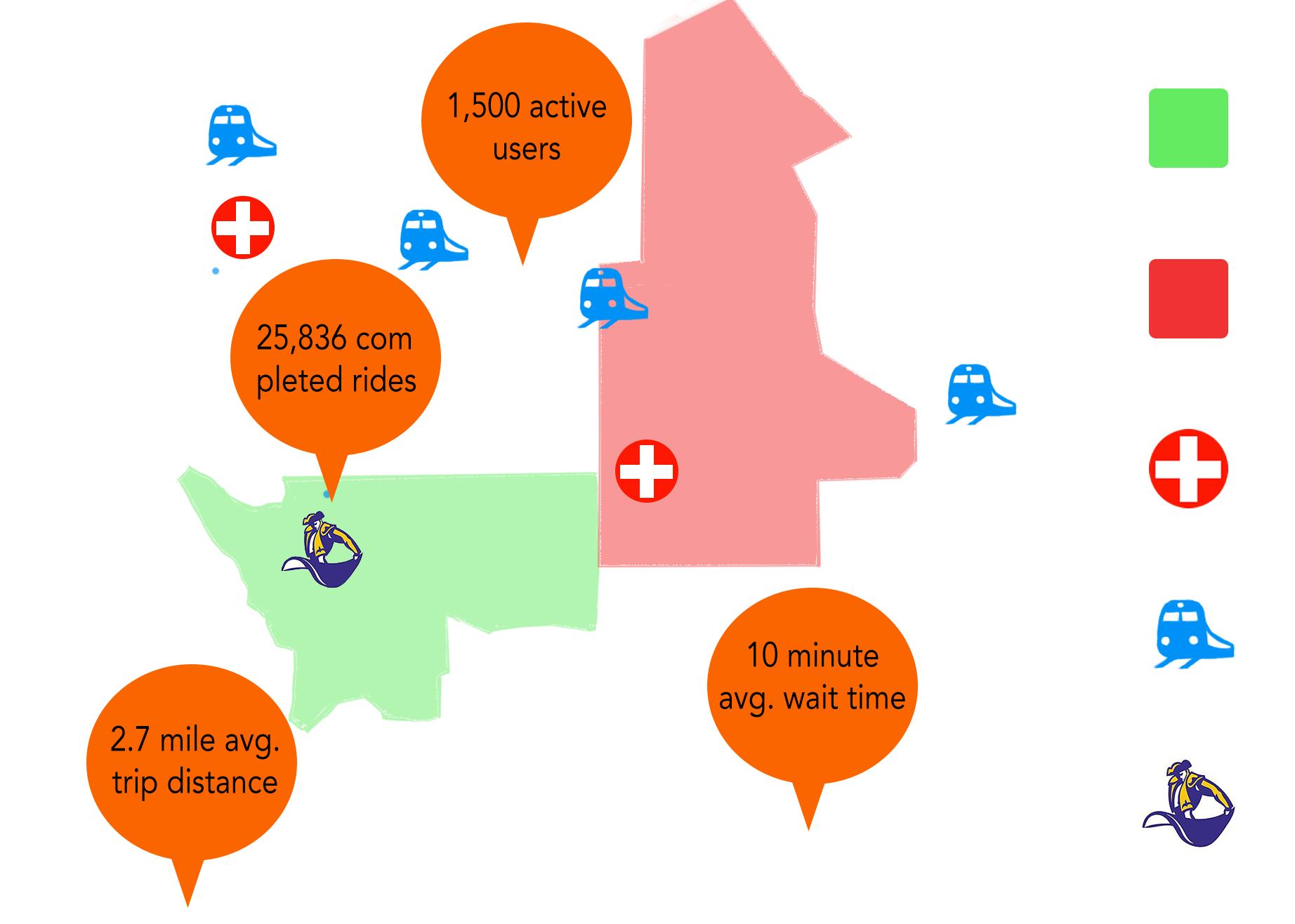
In the future, Corrao hopes Via will become a “true alternative to just driving.” Currently, he sees Via as a complementary service to the VTA bus system and other local public transit routes, intended to allow “people to transit in an easier, less stressful way,” as he doesn’t see Cupertino as a walkable city.
Corrao is hopeful that Via can eventually expand to include rail stations in Sunnyvale and San Jose and create a public transit system in
the West Valley, which traditionally has not had one. Additionally, Via is transitioning into an electric vehicle only service, with the ultimate goal of zero emissions. As its coverage increases, so does the potential amount of greenhouse gases that can be prevented, compared to if someone had a solo trip in a gaspowered car. According to a survey Via-Cupertino took of its users, almost 70% of Via riders said that if it weren’t for Via, they would have driven alone.
“The main purpose [of Via] was to have as big an impact as we could — the most benefit possible,” Corrao said. “You see exponential growth in the way it benefits the environment because of more people taking rail transit. The trips they take tend to be much longer and have a much higher environmental value, if you think about the greenhouse gases that come from transportation. There’s a lot more bang for your buck … that’s how I envisioned this growing and becoming a permanent program.”

Sidewalk installations aim to promote student safety and walking to school
BY MEGHA MUMMANENI AND KALYANI PUTHENPURAYILConcerns from the community regarding road safety on Orange Avenue are increasing due to a rise in vehicular traffic and a growing number of students walking every morning.

A sidewalk building project meant to combat these concerns was initially expected to be completed by February of 2022, but was postponed due to the pandemic. Hence, the construction began on June 10 instead.
Since third grade, junior Valerie Ayzenberg’s parents allowed her to walk with her friends to school. Ayzenberg says she was relieved to hear that sidewalks were being built on Orange Avenue.
“There [are] some places where it gets very crowded and thin [since parents] are trying to drive quickly to make sure [their] kids aren’t late,” Ayzenberg said. “People are trying to bike [and] walk, so it’s really [good] that they’re finally putting a sidewalk to make it safer.”
According to the Cupertino Capital Improvement Program, plans for the project began in 2016 due

to community members voicing concerns about the traffic on Orange Ave. Walk-Bike Cupertino adds that the construction is part of a larger mission of building sidewalks on McClellan Road and Byrne Avenue in order to promote walking to school and ultimately reduce traffic in the morning.
Cupertino Senior Public Works Project Manager John Raaymakers says that the $1.88 million project was funded by the City Council. Homeowners on Orange Ave. were allowed to choose whether or not they wanted to install the sidewalks on their private property.
give up property. It was [probably] in their best interest. We gave them information, shared the plans we had and respected their decision once they made
[THE MCCLELLAN] BIKE LANES HAD NOT BEEN PROTECTED — SOMEONE HAD TO DIE FOR THAT TO HAPPEN.
ART TEACHER
BRIAN CHOW
Art teacher Brian Chow believes that hiring crossing guards could be more beneficial and less expensive compared to building new infrastructure, though he wishes such changes could be made sooner.
“It’s an individual decision to participate or not [and] donate [their] property, and some people just weren’t sure what they wanted to do,” Raaymakers said. “They didn’t want to
“It’s unpredictable [and] dangerous and I’m surprised someone hasn’t got hurt,” Chow said. “Orange is fine, now that there is a sidewalk, but before, my concern would be people’s lives. [The McClellan Road] bike lanes had not been protected — someone had to die for it to happen.”
While Raaymakers says more improvements can be made, he also recognizes the efforts made to decrease traffic, such as implementing alternating bell schedules for Lincoln Elementary School and MVHS.
“Overall, the neighborhood is happy with the improvement, so that’s a win-win for the city,” Raaymakers said. “Seeing the differences in the neighborhoods that we make, talking with the residents that really seemed to appreciate it [and are] glad to see it finally because it has been a long time — it’s always very satisfying.”
Members of the community weigh the benefits and drawbacks of the 2035 gas car ban
BY MIHIR VISHWARUPE AND MIRA WAGNERThe California Air Resources Board announced an official bill on Aug. 25 that details a ban on the sale of internal combustion vehicles after 2035. California residents will still be able to buy and sell used internal combustion vehicles, but new ones will no longer be allowed for sale. The bill also maintains that hybrid vehicles will be allowed to make up to 1/5 of car sales after 2035.
AP Environmental Science teacher Lora Lerner believes the bill will be beneficial for a future of clean energy. Lerner is especially optimistic about due to the Inflation Reduction Act, passed on Aug. 7, which she finds will be essential to the banning of gas cars by providing $370 billion for clean energy.
“[The Inflation Reduction Act] is an important step because it provides that financial pressure for people to move because we [have to do] it faster,” Lerner said. “That’s the hard part — it’s really hard for society to change. So anything that any level of government can do to move it along is good. They’ve got to invest the money in making it possible for people, both on a personal level of affording it, but also to have the charging facilities on the grid.”

Senior Nikhita Saldi agrees with Lerner and sees the benefits of the ban, especially in terms of mitigating carbon emissions. Reflecting Saldi’s claim, the Air Resources Board states that the new regulations will reduce greenhouse gas emissions
by more than 50% by 2040. Saldi also highlights the equitable time frame for car companies as she believes 13 years is enough time to transition away from producing gas cars.

AP Environmental science teacher Kyle Jones
overnight charging will be difficult.
of MVHS students think that the 2035 gas car ban will be effective in reducing carbon emmissions
*According to a survey of 140 people
however, notices infrastrctural issues with the ban, pointing out that the difference between five minutes of filling a gas tank to 30 minutes or longer of charging one’s car may be an issue. He notes that charging in apartment complexes without access to
“I like [the ban] because I think it’s going to be an important step,” Jones said. “[California has] such a large economy and so many people, [often], things that California does sets a standard for sometimes even the rest of the world. I think it’s good that California is doing something very extreme, because then it will set a tone that other places might follow.”
Lerner echoes Jones’ statement and highlights the positivity of the step forward.
“When you talk about overhauling society, you have to do so many things, right?” Lerner said. “But it’s doable. When I see [bills like the ones recently passed], it gives me hope because it’s not that we can’t do it, we just don’t do it. Anything that moves us forward into actually doing [these things] instead of talking about it is really good.”
Since the start of this school year, finding space to park bikes has proven more of a challenge than in years past. According to a survey of 87 students, 68% of respondents felt that the bike racks were overcrowded in the beginning of the school year. For junior Krishna Nathan, not only has finding parking space become a more difficult task but even moving through the bike racks was also a struggle.
“When I’m biking into school and I’m entering the bike rack, I have to get down from my bike really early because there’s just a ton of bikes just crowding the entrance,” Nathan said. “I can barely even find a place to park my bike since there’s so many bikes, and [getting] my bike inside the bike rack is difficult because bikes are blocking all the walkways.”
When Nathan started biking a year ago, he had no problem finding a spot to park his bike, which he says is a sharp contrast to the current conditions. Other students, such as freshman Marian Mansour, voice similar opinions, pointing out that bikes get in the way of pathways.
“Sometimes [students] put chains on the gateway [of the bike cage], so it’s hard to navigate through it,” Mansour said. “It’s because the bikes are out [in the pathway]. I almost tripped on some because holding a bike and going through [the bike cage] is hard. Some people have to lift their bikes to get out. Yesterday I overheard some people saying it was hard to navigate.”
At the FUHSD Board of Trustees meeting on Sept. 22, Interact Club’s Cycle for Change team presented their findings on biking trends across all five schools. One of the problems that they identified was the “lack of bike racks” at MVHS given the increase in bikers.

believe bike racks were overcrowded at the start of the year
*According to a survey of 87 people
To explain the influx in bikers, Nathan believes that the recently changed bell schedules caused an increase in traffic, making biking more convenient for students. Nearby schools Lincoln Elementary School
and Kennedy Middle School start at 8:10 and 8:20 a.m., respectively, coinciding with Monta Vista’s new start time of 8:30 a.m. and creating additional traffic.

Junior Vatsel Srivasta is one student who bikes to avoid traffic. Srivasta acknowledges that he is able to travel to school multiple minutes faster when biking compared to driving. However, after seeing the bike rack situation this year, he believes the main reason for the increase in bikes is because the number of freshmen bikers this year is higher.
“More freshmen are biking,” Srivasta said. “That’s the real reason. I’m also seeing a lot more e-bikes on the bike racks, so people are finding that as a nice convenient way to go to school.”
Mansour has recognized many other freshmen using the bike racks at school and agrees that a surge in
new bikers could have contributed to the overcrowding. In addition, she feels that all students have been more inclined to bike due to increased safety precautions, such as the barriers that have been constructed around bike lanes.
In order to address the overcrowding, Student Conduct Liaison Thomas Michaelis rearranged the bike racks to include multiple columns of racks instead of a long line in the front at the beginning of September. After the bike rack reconfiguration, 77% of 70 survey respondents felt that the bike racks had improved since the beginning of the school year. Although Srivasta believes the new arrangement has made getting in and out of the racks easier, he still thinks that a larger bike rack area is needed.
“There’s no situation where bikes get in front of each other and no one can get out [anymore],” Srivasta said. “I’ve usually been able to get a slot pretty easily, but some days it’s more crowded. It just needs more space. I think the configuration is as good as you can get it in that space.”
According to Clausnitzer, adding a new bike rack is no easy feat. The current bike rack location cannot be expanded because the road next to it is already at the minimum width of 22 feet, in accordance with the fire code for fire trucks to pass through. One possible location for new bike racks that Clausnitzer proposed is behind the pool to replace the bleachers that used to be there. Clausnitzer described possibly partnering with Safe Routes to School or Cupertino Rotary to figure out the logistics involved with installing bike racks.
“Maybe students coming from the Fort Baker entrance would go straight down that D building access road and
head towards the pool,” Clausnitzer said. “That could be the type of solution somebody like Safe Routes could help us take a look at, but we’d have to do some measurements to [see] if it would be allowed per fire code.”
Despite the adjustments needed to adapt to the influx of student bikers, Clausnitzer notes the overall positives of having this problem.
“If we’re a school of 1,750 [students], and we’re still feeling the number of bikes in the bike rack, that would tell me that the percentage of bike riders has gone up,” Clausnitzer said. “That’s a good problem to have in the context of less students in cars, in terms of the climate [and] traffic.”

Principal Ben Clausnitzer had an idea for new bike racks to be installed in the space behind the pool, if they could meet the fire code.
The bike racks have been reorganized into shorter columns to create more space for students to walk through.
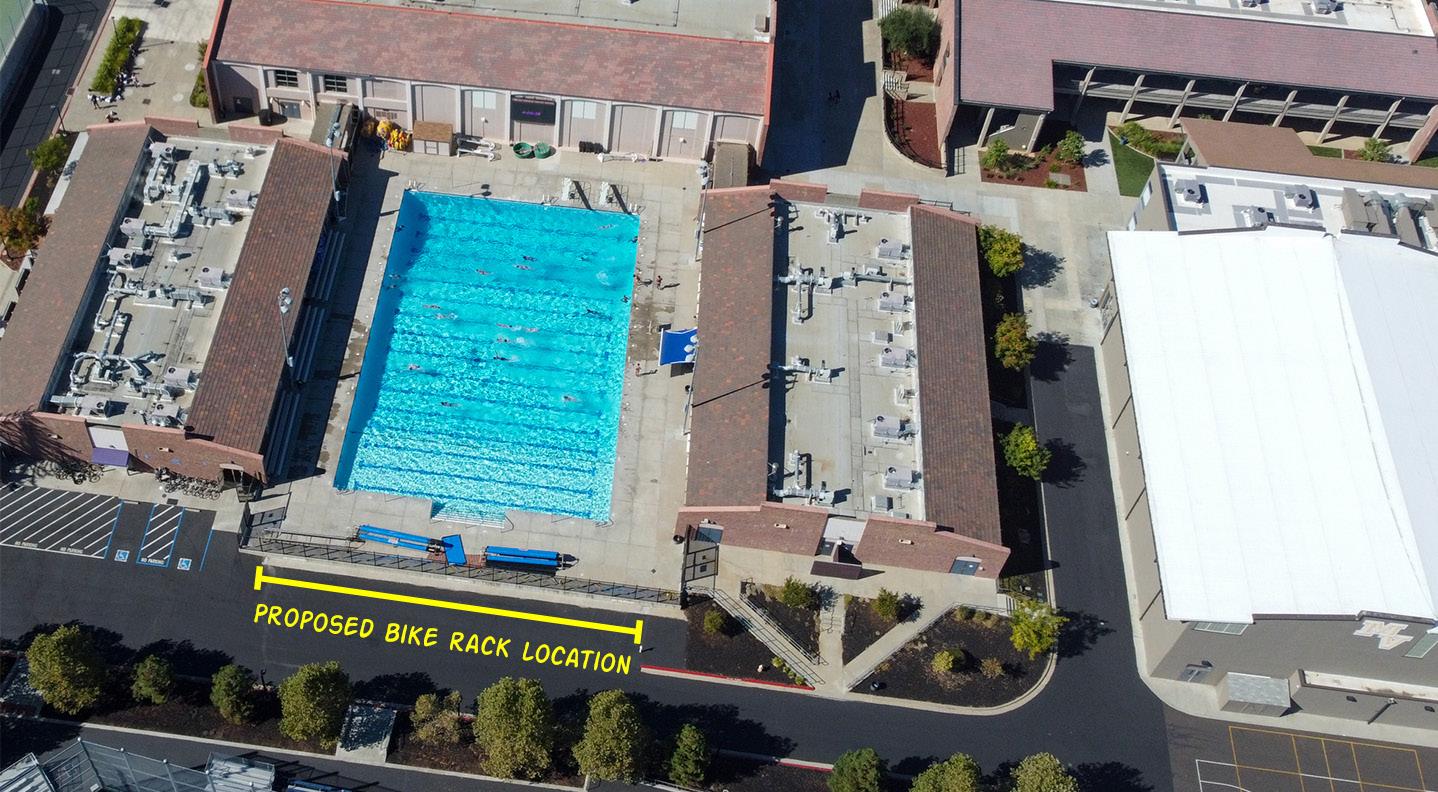
of


 BY KRISH DEV, YASH THAPLIYAL AND LILLIAN WANG
BY KRISH DEV, YASH THAPLIYAL AND LILLIAN WANG

wave


leading

object


Sept.
students
bomb
class placed

in the Welcome Back Rally on Sept.
was the leading Republican candidate during the California recall election?
dance team performed at Bobateeno on Sept. 17?

was the leading Republican candidate during the California recall election?
holiday did Spanish students celebrate on Sept. 19?
was the leading Republican candidate during the California recall election?

It was a rainy evening, so MVHS alum ‘21 Anika Deshpande and eight other new Delta Gamma members huddled inside Penn State University’s science building to take pictures with the group. Clad in their sparkly purple-pink, white and gold dresses, the colors seemed to reflect off the walls as the laughter echoed throughout the room. Deshpande says this was one of her favorite memories with her sorority sisters.
“I think one nice thing about that was we were all able just to spend time together and really get to know each other,” Deshpande said. “It was really fun getting ready for a homecoming dance and taking pictures with all your friends.”



In joining, Deshpande hoped to find a community among the 30,000 undergraduates who attended her university. Deshpande also joined in hopes of participating in school events that Greek life plays a large role in.
“We have a very specific schoolwide philanthropy called THON,” Deshpande said. “It’s a 46 hour dance marathon to raise money for children with cancer. Greek life is a very big part of THON, and it’s one of the best ways to get involved with it.”
On the other hand, MVHS alum ‘13 Siddharth Manoj joined the service fraternity Alpha Phi Omega at USC, which he describes as similar to Key Club at MVHS. This fraternity is for individuals who want to perform acts of service both in and out of school. Manoj volunteered as a tutor at an underserved elementary school near USC.
“I specifically tutored this one kid [in fourth grade] who I remember was really struggling when he first [started school],” Manoj said. “He was very rowdy and would not listen to anyone the first time I got there. I was like, ‘OK, this is terrible.’ But then after two or three months, I felt like I was making a difference because he started to
get better at what he was doing. He was actually listening to some of the advice that I was giving him. I think he was slowly learning and picking up on a lot of that.”
MVHS alum ‘21 Christy Feng, who was part of Kappa Alpha Theta at the University of Washington initially decided to join a sorority because she wanted to expand her social circle. However, after a period of time Feng decided to leave because she felt that her priorities did not align with other members of her sorority.
lot of people in my sorority are in very difficult majors and still manage to keep a high GPA and do a lot of other extracurriculars too.”


“In Monta Vista, everyonewas pushing each other to challenge themselves academically,” Feng said. “I don’t really see that [at the sorority], and in Monta Vista, there’s very much a go-getter attitude about your future and your aspirations. [In the sorority], there was just a different prioritization on other aspects of life, other than academics, which is totally fine. I just prefer a [more] work hard and play hard [mentality].”
According to a survey of 139 people
According to Feng, being in a sorority also comes with particular obligations, such as maintaining a certain image. In her sorority, all members were prohibited from posting explicit content across all social media platforms. Feng stated that these rules also protected her, since they prevented uncomfortable situations when it came to employers as most jobs check employee’s social media before hiring them. Although Feng found these rules restrictive at times, she believes that it did do more good than harm since they helped portray her in a better light professionally.
much more competitive to get if they weren’t part of the sorority.
“One of the main reasons people go to college is not only a degree but the networking opportunities, and I think that being in a sorority opens up your network,” Deshpande said. “We have chapter advisors who are professionals, and they give recommendations for jobs and [other opportunities]. It also helps you be a more well rounded person and a [stronger] candidate because you have to do training on how to [recruit] people and that helps you [become] more well spoken.”
Both Manoj and Deshpande encourage students to rush fraternities and sororities if they are interested, due to their personal experiences.

Deshpande believes there are misconceptions about sororities as some sororities focus on social aspects more than academics. She says while a lot of people think that the girls in sororities only join for partying, everyone she’s met through her sorority has been “well-rounded and hardworking.”
“There’s a GPA requirement to be in [the sorority and] we have the second highest GPA on campus for sororities and fraternities,” Deshpande said. “You have to fill out an application when you are going through rush and they’ll ask about GPA, community service and [philanthropy]. A
In other instances, Deshpande notes that alumni that were part of the sorority would be in positions where they are allowed to reference or hire people, and reached out to members of her sorority to ask if anyone was interested. Delta Gamma’s alumni network grants Deshpande and other members opportunities that would be
“Being in a sorority is definitely a positive experience,” Deshpande said. “I think there’s a lot of stigma around it and oftentimes people dismiss it, [but] if you’re on the fence about it, I would say go through recruitment. If you don’t like it, you’re not tied down to finishing recruitment, which is really nice. I know it sounds cheesy, but you’ll end up where you’re supposed to and for the most part it worked out
n her freshman year at Scripps College — a private women’s college in Claremont, California — MVHS alum ‘20 Serena Liu was one of two Asian people in her Core 1 class — a class focused on “diversifying one’s process of thought and narrative.” As the class discussed “Minor Feelings” by Cathy Park Hong, a book about the AsianAmerican experience, Liu found herself being constantly singled out and asked for her thoughts by her professor due to the fact that she was AsianAmerican herself.
Though she believes he had “no ill intentions,” Liu felt the experience was “jarring” and was a contrast to what she experienced at MVHS, where “almost everyone” was Asian so she was never singled out in that manner.
“We had affinity groups for certain ethnicities, cultures and religions [at MVHS], [so] I never felt the need to join any of that because I always felt like I was the majority,” Liu said. “I didn’t feel
like I couldn’t find a community. That [was] until I came to college. I saw the demographics and I was like, ‘Wow, there are a lot of white people.’”
Compared to the 80% Asian student body at MVHS, the Scripps’ student body of approximately 1,000 students is 17% Asian. Liu shares that she found solace in meeting other Asian-Americans because her identity helped facilitate networking and friendships.

“[At MVHS, being Asian-American] wasn’t anything special,” Liu said. “But [at Scripps], I definitely went through [the experience] of finding myself and my own identity [because I was] exposed [to] a predominantly white institution.”
Despite Scripps being 50% white, Liu says the minority groups attending the school are much more diverse than at MVHS, especially regarding mindsets. MVHS alum ‘21 Nelson Mu, who attends UC Santa Barbara, agrees that attending college has exposed him to a broad variety of communities. For example, Mu shares that his participation in a labor organizing group, where there are almost no other Asians and the “vast majority” of participants are Latinx, gave him exposure to new ideas. Even among people pursuing the same major, Mu acknowledges that everyone’s path is different, resulting in a less competitive environment.
“[My] college experience is so unique,” Mu said. “Everybody’s pursuit of [their] major is so diverse that it’s difficult to stack yourself up against other people. College is a lot more about improving yourself than it is about doing better than all of your peers.”
MVHS alum ‘21 Eugene Yoon, who currently attends Carnegie Mellon University, echoes Mu’s sentiment,

sharing that he is now able to better enjoy activities he participates in thanks to the absence of overly competitive peers. Yet, he also acknowledges the challenges that come with newfound independence.
“[At] Monta Vista, I was doing things just for the sake of it, and it did not make me happy,” Yoon said. “Being in college, I’m able to do things a little bit out of my own spirit. It’s been helpful for me [in] managing my mental health while enjoying the things that I do. But with that freedom also comes the fear of being irresponsible.”
While adapting to college life, both Liu and Mu initially struggled with time management, citing motivational and productivity challenges. Mu in particular struggled with his workload and was stunned by the pace of the courses: contrary to the slow start of high school, Mu shares that his professors lectured course material on the first day.
With a student body of roughly 26,000 students, Mu considers UCSB a large university. Mu feels that one of the biggest advantages of being at such a large university are the amount of opportunities, especially in terms of clubs
and organizations. For example, according to Mu, there are at least six Chinese related clubs at UCSB, as opposed to the single Chinese Honor Society club at MVHS.
However, Yoon, whose school has a population of approximately 14,000 students, explains that smaller college sizes were the deciding factor when he was applying. He believes that obtaining a high level of education is correlated with cultivating studentteacher relationships, and CMU’s smaller size has allowed him to connect with professors on a “more personal basis,” which he feels has “greatly impacted how [he] learned.”


Liu agrees that smaller schools are great for networking and connecting with professors but believes that smaller schools can impair one’s social life by fostering clique culture.
“If you are not vibing with someone at a big school, you always have the option to just find someone completely new and it’ll be fine,” Liu said. “But at a small school, if you don’t vibe with someone, you can’t just cut off
ties that easily [because] finding a new group is a lot harder.”
Despite some of the difficulties she experienced at college, Liu shares that her time away from MVHS has ultimately helped her understand that MVHS students struggle due to high standards. Thus, Liu advises that students should not prioritize academic success at the expense of their well-being and self-worth.
“I feel like college applications really force people to reevaluate their self worth, which I think is so unhealthy,” Liu said. “But everyone at Monta Vista [should] be proud of what they’ve done. [College is the] start of something new. It’s not the end, it’s [the beginning].”
The color pink filled his vision as the springtime sakura blossoms bloomed in Kyoto, Japan. Among the conversations of Japanese pedestrians, the vastly different languages of English, Spanish, Vietnamese and Japanese dialects spoken by his friends and roommates surrounded him. Walking in the crisp air with a group of international and Japanese students, MVHS alum ‘21 Neo Nishino felt the moment was surreal.

Although Nishino currently attends Ritsumeikan University in Osaka, Japan, studying abroad in an English-based international program for a Community and Regional Policy Sciences Major, it was never his plan. Despite holding dual citizenship, Nishino has lived a majority of his life in the U.S., only residing in Japan for a single year in fourth grade. Given the cheaper tuition and opportunities to connect with his culture and find work in Japan, Nishino decided that this was the best path for him to take.
Other than the fact that “a good population” is Asian, Nishino noticed that compared to Cupertino, studying in Osaka is “a 180 degree difference,” specifically noting that Japan is a country that could “fit inside of California” with a train system that could take him virtually anywhere in the country.
significantly lighter workload than at MVHS.
“You realize how advanced MVHS’s level is,” Nishino said. “You guys are crazy smart and that’s the thing. You [also] realize how diverse MVHS is despite it being in America [because] you learn a lot. [In Japan], I might be in a class talking about cultural encounters — they might be talking about China as if you’ve never heard about China or never talked to anyone Chinese, but I’ve kind of done that every day [in Cupertino]. I mean, heck, I’ve been to their house, to their parents’ houses and talked with their parents.”
Although Nishino is the “black cat living abroad,” he doesn’t feel like he has left his life in Cupertino behind. Instead, he has set himself on “a different set of rails” that has led him to a new country and future that better aligns with the life he has always imagined. While living in Japan comes with its challenges, Nishino has been able to do things that others “just see in an anime” — such as attending night festivals, going to temples and participating in club activities. Since living abroad, Nishino has realized that he will always be responsible for his Japanese culture, but his home will always be the Bay Area.
In terms of his school, Nishino notes that Ritsumeikan has a larger campus, food that is both cheaper and better-tasting than MVHS’s and a
“Because you live in Cupertino and you go to MVHS, you don’t realize how rare your gift is — of speaking two languages and knowing what America and other places [are] like,” Nishino said. “You realize that you’re a needle in the haystack and people will look for that and they will pay a lot of money for that … You’ll come to learn that you’re different [and] you’ll come to value your life a lot more. ”
PHOTO COURTESYDuring the fall of her freshman year at the Massachusetts Institute of Technology (MIT), MVHS alum ‘20 Audrey Cui applied for the Undergraduate Research Opportunities Program (UROP). While she was initially hesitant, Cui applied after recalling something she had heard in her high school English class — men apply when they meet 60% of the job requirements, while women only tend to apply after meeting 100% of the requirements.

her into a wall of burnout and a lack of motivation, Cui ultimately learned to separate herself from work and academics. Her change in mindset allowed her to be more comfortable and take time for herself.


“At the end of the day, if you get into MIT, that’s great,” Cui said. “If you don’t get into MIT, at least you spent your time doing what you enjoy and care about. Probably, [furthering yourself as a person] more than MIT would. I

At UROP, Cui says she had the opportunity to collaborate and contribute to real research. An example of the research she worked on is relighting light sources in images.
“We did this by generating pairs of fake images with different lighting conditions to train a model that does image-to image-translation,” Cui said. “This model learns how to ‘translate’ an image under certain lighting into the same scene but with another lighting condition.”

Furthermore, UROP allowed Cui to explore her interests in a community of people who she respected, including her mentor David Bau, an older grad student who had worked as a software engineer before getting a PhD. Cui believes Bau is a “really wise person” and guided her throughout her research and was there for her with his “happy go lucky personality.”
However, there are times in research where Cui is unable to rely on others and has to deal with challenges. Cui recalls a time when a research paper she worked on for 20 hours was rejected from publication. Though she says the initial rejection was detrimental to her mental health and drove
think it’s great that MIT definitely has the resources to help you develop these passions further, but to be honest, other schools do as well. At the end of the day, just do what you enjoy
The moment MVHS alum ‘20 Yoanna Lee moved into her dorm
at Franklin & Marshall College, she was greeted with an immediate 72-hour quarantine. She remembers that many COVID restrictions were in place, such as food being delivered to her door and only leaving her dorm to use the bathroom.
“My mom flew all the way from [Philadelphia] to help me get there and unload,” Lee said. “She was going to buy me dinner, but they said [that she] had to leave. My mom [was] crying for hours from the window saying bye, and it was really heartbreaking.”
While COVID restrictions have died down, Lee’s experience reflects the independence and change that students face while going to college, especially in dorms. MVHS alum ‘21 Oishee Misra highlights how she spent less time in her dorm than she normally would at home.
“In college, your schedule is a lot more malleable because you get to pick when your classes are,” Misra said. “Typically, there are a lot more breaks in between classes, and you can have late night classes. The biggest change for me was figuring out what I wanted to do [during] those empty spaces in between my classes. Because of that, I ended up spending a lot less time in my dorm than I would [have spent] at home in my room.”
MVHS alum ‘22 Leela Srinivas echoes Misra’s feelings regarding her newfound independence, as she quickly realized she lacked the
necessities she would typically expect at home.
“When my parents left, I was crying from moment to moment, and I was like, ‘Damn, I don’t have tissues,’” Srinivas said. “What am I supposed to do?”
Misra shares that living in dorms exposed her to a unique environment. Rooms in resident halls often house two to four people, and multiple rooms are connected to a shared bathroom, with amenities like kitchens and study spaces nearby. Some colleges like Misra’s also offer on-campus apartments.

This communal living helped facilitate a social environment for Misra amid her newly gained independence.
“This was my first time living with other people, and I actually really enjoyed it,” Misra said. “I didn’t think I would because I’m pretty introverted, and I don’t like being around people all the time. But I feel like when you go to college, everything is new. You don’t know anyone, so it really helps [to live] with other people. A lot of the time, your first friends at college are your roommates.”
Dorms also have resident advisors (RAs), or other students that help enhance dorm culture and increase bonding. Lee’s college house elects people to a parliament to host dorm events, similar to how Leadership at MVHS hosts on-campus events.
“One thing we do is sundaes on Sundays,” Lee said. “They always get ice cream for us on Sundays at 9 p.m. The whole dorm goes downstairs, and we’re all eating ice cream.”
MVHS alum ‘21 Harini Aru believes that dorm events are a key part of getting to know others, but a lack of effort from her RA made it difficult for her to bond with her roommates.
“I know some RAs were really proactive and organized a lot of
floor events, and that created a lot of bonding among people living on the same floor,” Aru said. “A lot of [my friends] became really close friends with other people on their floor. Our RA didn’t put [in] that much effort. For me [and my roommates] personally, we would smile and say hi, but we were just roommates in the end. I found a lot more of my friends through my classes and going to events outside.”
started freaking out and throwing stuff around the dorm. Some of [my friends] actually did end up moving out because it was such a hostile environment.”
Srinivas shares an experience similar to Aru’s, saying that most of her relationships formed outside her dorm.
“The time spent in your dorm [compared to] the time spent at home is wildly different,” Srinivas said. “You can basically spend all of your time outside of your dorm if you want to, which is pretty different, especially growing up in Cupertino, where everything is 10 minutes away by car. I’m more likely to make friends in classes or clubs since [those are where I’ve mainly been].”
MVHS alum ‘21 Patrick Nguyen describes that sometimes, other factors affect alum’s abilities to become friends with people in their dorms.
“We lived with an RA, and he was really annoying,” Ngyuen said. “He didn’t clean anything. Sometimes people will just be screaming and stomping around while other people will actually be respectful of your boundaries. [One of my friend’s] roommates was failing [class] and they


To avoid causing issues for roommates, Nguyen suggests that before coming to college, MVHS students should learn basic skills like doing laundry and cleaning up after themselves. He also recommends that students create an environment in their dorm that will foster productive learning. For Lee, personalizing her dorm created a safe space she felt best in.
“Be excited and get creative with how you’re going to decorate your room,” Lee said. “Your dorm room is going to be the place that you come home to rest. Even though you’re going to live

there temporarily, [still] make it the place where you feel like you’ll be happy, because there aren’t a lot of places on campus that can do that. You have to create your own safe space.”
Misra also agrees with the sentiment of finding ways to put worries aside. While the transition to college might be stressful, Misra says her initial worries regarding moving and losing valuable friendships diminished with time.
“Honestly, when you get to college, all of that [worry] kind of fades away,” Misra said. “It’ll work out. Dorm life is one of the most exciting things about college. There’s something very special about the friendships you make at college — [it’s] a once in a lifetime thing. You’ll get to stay in a place with so many other people in a walkable community where your whole life will be on this little campus, and I think it’s just a very special thing.”
MAKE IT THE PLACE WHERE YOU FEEL LIKE YOU’LL BE HAPPY, BECAUSE THERE AREN’T A LOT OF PLACES ON CAMPUS THAT CAN DO THAT. YOU HAVE TO CREATE YOUR OWN SAFE SPACE.
YOANNA LEE
Coming to terms with the individual impact we have on combating climate change

Bike to school instead of driving.
Eat less meat. Turn off the lights when we leave the room. Don’t use plastic utensils.
In the last century, the Earth’s temperature has increased by 2 degrees Fahrenheit due to human behavior. If this trend continues, there will be catastrophic consequences — some of which are already emerging — such as major heat waves and flooding, mostly impacting lower socioeconomic communities and magnifying the effects of the income gap. As unintentional contributors to the cause, we often embed small practices in our lives to try to help alleviate the impacts of a devastating situation.
But our mild inconveniences are outweighed by the monetary profits big companies reap through choosing to invalidate or simply ignore climate change. According to The Guardian, since 1988, 100 companies have caused 70% of the world’s industrial greenhouse gas emissions, and more than half of those emissions can be traced to just 25 corporations.
When compared to these 25 corporations, our efforts appear minimal, outweighed and essentially negated. How much of an impact does choosing to bike have when Taylor Swift has used her private jet 170 times in 2022, with flight emissions 1,184 times higher than the average person? Looking at these statistics, it may feel like there’s nothing we can do as individuals to fight climate change,
which perhaps stirs up a feeling of powerlessness.
As individuals, there are some ways we can contribute to the fight against climate change on a larger scale. We can choose to support companies that have made commitments to fighting climate change: Apple has invested $4.7 billion into green technology and Nike intends to run on 100% renewable energy by 2025. We can also harness the power of grassroots democracy to create change by writing letters to our state representatives and senators asking them to support environmentally friendly bills.

through: we expect Apple to continue investing in green technology and our senators to read our letters and advocate for climate friendly bills. Realizing this, we again return to a feeling of powerlessness — a lack of agency that means acknowledging that our efforts will never amount to what we hope they will. How are we supposed to deal with this?
However, our individual
Unless we have some loophole that can somehow magnify our individual impacts to a tangible extent, we just have to validate this feeling of powerlessness and, more importantly, realize that there’s nothing wrong with it. We are just one person in a world of almost eight billion — our power to make change is limited. Accepting that biking to school will not solve climate change is one step toward realizing that we as individuals should not have to bear the responsibility of the health of our planet alone.
But this shouldn’t be an excuse for inaction. The worst thing we can do for the fight against climate change is give up hope, because we would be not only conceding the possibility for saving our planet, but also essentially exacerbating climate change by choosing not to take action against it. Instead, we have to recognize that our role in the solution is minimized, and as long as we continue practicing climatefriendly habits, that’s the most we can and should expect from ourselves.
Amass of Matadors huddle together on the bleachers, floodlights illuminating their matching attire. Senior and ASB President Justine Garcia shares that people in the stands make school spirit events more interesting, because “everyone is happy to be a Matador and they all want to have fun.”
Junior Aya Abdelrahman adds that representing MVHS by dressing up and participating in rallies and dances are fun ways for students to de-stress in school. Senior Alex Li agrees, saying “[school spirit is] important because it gives students a chance to bond with each other and provides a fun environment in an academically challenging school.”
However, some students believe the academic culture of MVHS requires students to prioritize school over spirit events. Junior Nithya Appannagaari says time spent attending school events would be better used to finish work, especially because many events like rallies take place during tutorials, which can be used to “catch up on work and visit teachers.”
“I feel guilty for going to rallies because I think to myself, ‘Oh, I should be working really hard on this thing,’”
Appannagaari said. “Instead of going to a rally, there’s this idea that you’ve got to constantly keep on working.”
Senior Clay Carson thinks school should be more about “learning and succeeding in class,” and that he’d rather interact with his friend group or people closer to him rather than the school as a whole.
In contrast, junior Saketh Korada argues that school spirit events are important stress relief because of the academic culture of MVHS, believing some people focus too much on academics
and “forget everything else.”
Garcia explains that ASB tries to combat this by prioritizing “give over ask,” that is, prioritizing events that require little effort from the student body, by planning smaller events that “don’t ask the school to do ginormous things and force them to participate.”
“We give them more [smaller] things so that it’s easier for them,” Garcia said. “Bring your own mug is always a popular thing because we provide cups and they have something to do. Or we pass out Otter Pops or do Polaroid backdrops. I think it’s just the small things [we do] like music or bubbles.”
Li agrees, saying “a lot of students would rather have a school event than a test, [and school spirit] definitely helps relieve stress when there’s something fun going on.”

On the other hand, Carson explains he does not like going to school-wide events because of his personality. He explains that school events are often too loud for him and require too much energy.
Although Carson doesn’t attend school spirit events, he still sees the importance in school spirit because it helps unify the school. Abdelrahman echoes his sentiment.
“It kind of unites us,” Abdelrahman said. “Like when the seniors cheered last year it was like a goodbye, and whenever we do it it makes me like ‘Oh my god. This whole section is juniors — we’re all [in] the same boat here.’”
PHOTO


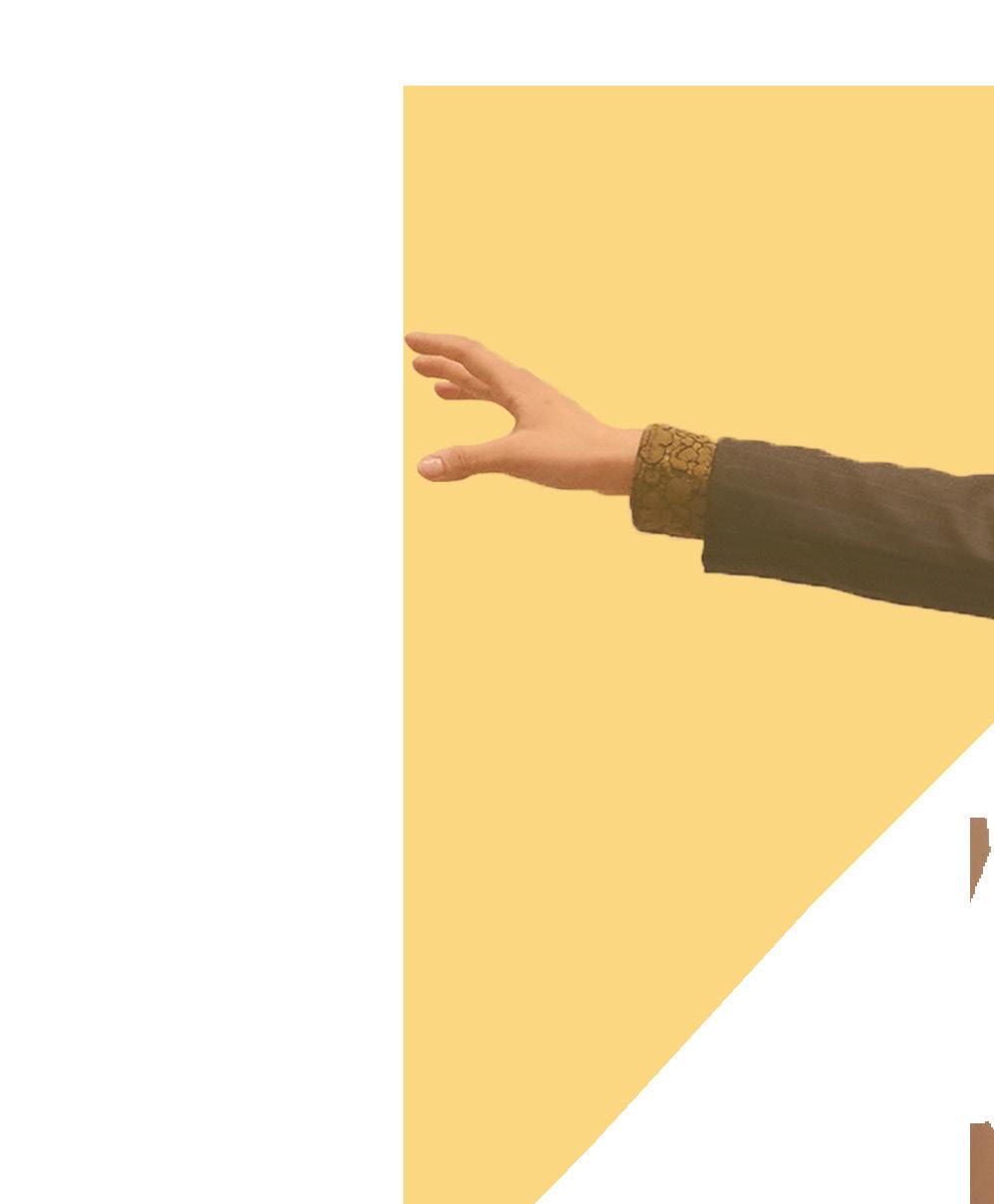
been playing piano for as long as I can remember. With my previous teacher, I distinctly recall the little ritual we’d have at the end of our piano recitals. After we’d all taken our bows and been smooshed together for the parental paparazzi to descend on us like a flock of starved vultures, we’d each receive a little plastic trophy for our “hard work.” In simpler words, a participation prize.
At first I was thrilled, as any 10-year-old child would be with receiving something that inflates their ego. However, as the years passed, I found myself enjoying piano less and less. I got to the point where I’d rather sit on the piano bench, debating for 30 minutes whether I truly wanted to practice, then do something actually useful with my time.
It wasn’t until I changed teachers to my current one, with whom I received absolutely nothing for playing at a recital (besides the feeling of wild fear that happens when your sweaty fingers begin to slip off the keys), that I began to find myself looking forward to playing again. It seems counter intuitive, right?
Often a highly debated topic, participation prizes have been the subject of scrutiny, with many who deem them unnecessary. It’s important to note, however, that

participation prizes can be important at times. For example, in the case of
participation prizes are a facet of extrinsic motivation that serves no
drawing, those offered a reward for doing it were less creative than those who weren’t.
To be perfectly clear: there will always be a culture of extrinsic motivation. There has to be. If everyone only participated in activities they enjoyed, no one would accomplish anything. However,
our ability to ingest unholy amounts of caffeine), it’s also important to stop once in a while and consider whether the path we’re pursuing is one that we actually enjoy.
If you only pursue what will yield the most reward, the most money, rather than what you love, all you have left is putting work into something you’re not passionate about. After all, your academic achievements won’t mean as much later on in your life if you’re stuck in a job you hate.
THAT SERVES NO CONCIEVABLE PURPOSE OTHER THAN VALIDATE THE NEED FOR A REWARD.
Of course, it’s always easier said than done. It’s not easy to break out of a mindset that’s woven into every fiber of your life. Perhaps you don’t even want to break it, content to continue because what you’re doing works. But just because that headspace works, doesn’t mean that it’s healthy. You don’t need to completely change yourself; you just have to start somewhere.
So, if you find you cannot muster up a drop of motivation for a certain subject, or if you’re participating in a club purely to get that participation prize and putting it on your college resume, perhaps ease off a bit.




Tell your club leader you need a bit of a break and need a week or two off. Focus less on trying to complete that bit of code you can’t figure out and more on your literature essay. Or even just spend that time to go outside and touch some grass (God knows we all need to). If you find that you really do want or need to continue the activity, you can continue no harm done. And if you find that stopping does not mean that you will be smitten by God from the heavens above, then quit.
After all, life’s too short to waste chasing after some unsustainable pipe dream for the sake of a cheap piece of plastic or one line of text to slap on your college application.

Take a step back. Find something you truly enjoy. And for our continued pursuit of passion, let’s stop giving out participation prizes.

The moment the work begins to accumulate, the stress intensifies, a gray haze that narrows a student’s focus to the impossible number of tasks on their to-do list. That haze darkens when, in the background, they hear the sharp opinion of a parent determined to ensure quality work. The critical voice only softens when it is presented with an A grade.
“I like to believe [parents are] happy when we’re happy, but I feel like it’s more when we accomplish things,” senior Ishita Pesati said.
According to the Times of India, transactional relationships are based on the concept of reciprocation and mutual exchange, and those involved expect to gain benefits. All engaged parties expect to have their emotional
and relational investments repaid in the form of equal returns, and people focus heavily on what they are getting out of the relationship.
Although such relationships seem almost business-like, some parents and children have a bond that is reminiscent of this concept. In the world of parent-child relationships, this type of bond is an example of conditional love. According to a study published by Scientific Research, conditional regard is a parental attitude in which love and affection shown towards children are contingent upon their completion of certain expected behaviors. With this form of parenting, parents often reward their children with affection and appreciation for “good” behavior and express disappointment when presented with undesired results.
When conditional parenting is applied in academic settings, desired results become synonymous with stellar grades and strong performances in extracurricular activities. At MVHS, our strenuous academic culture can create transactional relationships between students and their parents, with parental appreciation being based on a child’s academic success.
Ishita Pesati speaks of occasionally feeling like she has a transactional bond with her parents, in which they only care about her grades and physical health.
“As for a relationship [with my parents], I feel like it’s mostly based on academics,” Ishita Pesati said. “Emotionally, it’s just non-existent, unless I’m visibly upset or broken down, which I don’t usually like to do.”
 PHOTO | MICHELLE ZHENG
PHOTO | MICHELLE ZHENG
To Ishita Pesati, her parents’ happiness and appreciation seem contingent upon her accomplishments. She speaks to an example in which she presented her parents with a high PSAT score, one that qualified her for a National Merit Scholarship, but felt ambivalent about the pride that her father expressed.
“I’m just like, ‘Are you proud of me? Or are you proud of my accomplishment?’” Ishita Pesati said. “It’s only when something is finally accomplished that they say they’re proud of me.”
Ishita’s dad Vikram Pesati speaks about his parenting philosophy by emphasizing his belief in the importance of letting his children know that challenging themselves is vital for their growth. To Vikram Pesati, showing his children the path, work and discipline required for success is of the utmost importance.
“We listen, we coach [and] we also critique,” Vikram Pesati said. “We are the people who truly care about them, as kids of ours, and we will be the honest critic — we’ll say it like it is.”
However, Ishita Pesati says selective focus and affection impact her relationship with her parents, and she often struggles to maintain her trust in them.
“Your parents are kind of the one thing other than yourself that stays pretty much constant throughout your whole life,” Ishita Pesati said. “Not being able to trust them or have a good relationship with them for your whole life, it sucks.”
School-based therapist Richard Prinz further speaks to the negative effects of transactional parenting on children, stating that it often causes children to withdraw or fight back against set expectations
and stunts their social-emotional development.
“If you’re just focused on grades, GPA and what college [your child] is going to go to, you’re missing the whole social-emotional dynamic, which is more important than academics,” Prinz said.
“When [children] go away, they’re not prepared for the socialemotional challenges of college.”
However, Prinz does provide tactics that parents can utilize to better support their children through stressful academic situations, including reflective listening, suspending judgment and understanding the problem. Additionally, he emphasizes the importance of encouragement and motivation.
Ishita Pesati agrees with the impact of conditional parental appreciation on emotions, claiming that parents often don’t realize that “emotionally, they are ruining their kid.”
“Encouragement is the cornerstone of good parenting,” Prinz said. “It’s staying calm, having a conversation, being curious, trying to learn and seeing that in that kind of a conversation, problems can be solved.”
Senior Suhani
“It leads to issues down the road with trying to make relationships, making friends and being emotionally trusting,” Ishita Pesati said.
However, Prinz does give concessions to parents, claiming that the immense amount of pressure put on parents by their jobs and responsibilities can impact the way they interact with their children. Similarly, Vikram Pesati states that every parent and child is different and that parents are often learning as they go through the parenting process themselves.
“Parents are not perfect — no one is — we are experimenting as we go along,” Vikram Pesati said. “And I’m sure we probably sway [from] this end of the spectrum to that end. It is all part of the parcel of parenting.”
Vakhariya’s mom Archana Singh also expresses her strong belief in the value of supporting her child through her emotional ups and downs and allowing her space to fail and rebuild. To her, conversing with her child, encouraging her to take constructive criticism and being transparent about the importance of hard work help her push her child through her academic stress.
“We have to motivate them. We have to challenge them. At the same time, we have to be supportive,” Singh said. “It’s OK to fail. Failure [is] the building block for success, so that’s perfectly fine.”
In the realm of academics, providing support and motivation through the study process helps children initiate their own learning and naturally increases their achievement levels.
“Just know that your kid is probably trying their best. But also, if they fail, they’re beating themselves up on their own. They don’t need it from you as well,” Ishita Pesati said. “Parents should be aware that the way they treat us now is a deciding factor in whether they get to be a part of our future lives.”
‘‘
NOT BEING ABLE TO TRUST THEM OR HAVE A GOOD RELATIONSHIP WITH THEM FOR YOUR WHOLE LIFE, IT SUCKS.
Eight of El Estoque’s survey respondents share their experience
BY RIYA MURTHYDuring the bomb threat, I was really worried. Although we’ve seen this happen in other schools across the country, I would have never expected it would happen to our school. Afterwards, I was definitely nervous and one of the things on my mind was if our school was still a safe place.”
Kate Yang (9)
During the first bomb threat, I was a little nervous due to the possibility of an actual bomb in school, but was mostly calm since normally most school bomb threats are fake. When the second bomb threat happened, I was quite annoyed because I like school on Fridays and was missing out on one of my fun classes .”
Krittika Paul (9)
I didn’t think much during the bomb threat. My thoughts were just ‘OK cool, I guess someone doesn’t want to go to AP Chem.’”
Shaunak Joshi (12)
Sure, this is probably a bluff made by some student to try and skip a class or test, but it should still be taken seriously based on the unknown threat that may lie within the school. Whoever is bluffing ought to be punished.”
Aaron Lee (10)
“Look, this is not surprising to me at all. What do you expect in this country? We already saw the Texas shooting — same things are going to happen everywhere.”
Nimai Garg (9)
“I think that the bomb threats were cruel since it scared many students and no one knew what was happening. It also makes people scared that it might happen again.”
Ankita Krishnan (11)
“I felt at the time no different than usual. I considered the possibility of a bomb at school very low, and I still hold that to be true. But I believe the caution was justif ied.” Anonymous
“I was scared at first, but after we were evacuated, I was fine with it. After the second bomb threat, it was annoying.”
Anonymous
“

Honestly, I can’t wait until I graduate and go to college.
For years, that’s been my dream — the distant destination that I look toward when I’m frantically flipping through my textbooks at 3 a.m. Just a few more years, I tell myself, and then I’ll be free of the torturous hell that is school in the Bay Area.
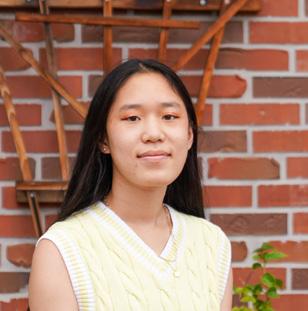
With declining enrollment and teachers leaving and everyone complaining about test after homework after test, it feels like I’m getting ready to jump ship from the Titanic.
Every day I feel desperate to leave, grasping at the last lifeboats of college enrollment.

And then what?
Often, I’ve heard teachers say that we live in a bubble, where we are cushioned by our celebration of culture, our excessively obedient study habits and our peaceful neighborhoods. And it used to piss me off to think that anyone could suggest that we, the battle-hardened test takers and experts at coping (well, more like surviving) with stress, would ever fail out in the “real world.”

But I also can’t help but worry. When I pop that bubble of safety, what comes next? What happens to the life that I’ve gotten so accustomed to?
I know every inch of Cupertino. I’ve explored it and memorized the best restaurants and boba places and cafes. Every corner holds little memories of manic laughter during math classes, after-school coffee runs and walking home riding the high of the school bell tolling.
I see Cupertino in the same way I see my friends: the type of near and dear that comes from our quietest, smallest conversations and crying together. It’s trauma bonding in the most ironic of ways, in that sometimes I wonder how I ever survived so long, and other times I wonder how I could ever consider abandoning this.
stop the flow of time. Every day I realize just how little time I have left to savor my home, and it just makes me all the more ready to throw myself into life. When I go off to college, I don’t think I’ll be totally ecstatic. If anything, when I think about it now, it feels like the world is going to end.
But if all of my history here, the familiar buildings and
Honestly, I
‘‘Sometimes I wonder how I ever survived so long, and other times I wonder how I could ever consider abandoning this.
The door shuts.
They’re gone. After a full week of leaving the house, seeing my family in the living room, and coming home from school with my family still in the living room, the time has finally come. I’m home alone.
Calling out “Mom!” and “Dad!” while frantically pacing my house, I make sure that there is no possibility that anyone is still at home. I do not want to get caught. I had been waiting all week for this, anticipating
laptop and opening up YouTube to my most searched channel — “Sing King Karaoke.”
Searching through the five new videos uploaded to the channel in the past week, I clear my throat with joy before ultimately deciding on my all-time favorite — “Rolling in the Deep” by Adele.
As the bright logo of “Sing King Karaoke” flashes and leaves the screen, I open my mouth and become Adele.

Well, one can dream.
I absolutely love to sing. I’ve been doing it ever since I was little; in fact, I was the one who begged my parents for singing lessons at the age of 5. So, for the past decade, I’ve taken classes with three different Indian classical vocal teachers — I wanted to be like Shreya Ghoshal, my favorite Bollywood singer. Her seemingly
effortlessly beautiful voice, I knew, was not actually effortless — and if I wanted to be like her, I had to put in the work.
Any time I needed to practice for my music lessons, I would do so diligently — with my iPhone playing the tabla (Indian drums) in the background as I warmed up for 30 minutes before singing the actual song I was learning in class that week. My mom insisted on me practicing in the room next to the kitchen so that she could hear me while she cooked dinner.

I hated it.
Not the music — I loved the music. But I hated the fact that every time I practiced, I felt like I was performing — like I had to be better than last time so that my mom could hear me through the walls and smile a little harder. Practicing for my vocal

lessons felt like a chore because I wasn’t doing it for the fun of it anymore, I was doing it for external validation.
But when I’m all alone at home, the acoustics of my living room match the tone of my favorite pop songs perfectly, and I am fully me — not the perfect, hardworking music student I strived to be all my life. Being proud of myself, I realized, means just a little more to me than others being proud of me. Looking at my reflection in the TV, panting a little as I finish belting a high note for no one else but myself and the furniture around me, I feel like I’ve been taken out of reality for a little bit and into a world of my own. It feels cathartic.
One day, while I was singing one of my favorite Broadway songs in the living room, my biggest fear came true. Hearing the sharp “ding” of the house’s alarm system, I realized what had happened. As I turned around, belting the ending note of the song, I saw my mother standing in the kitchen, her arms crossed and eyebrows raised. I thought she was going to get mad at me. For what, I don’t know. For being too loud? For sounding bad? For singing nonclassical music?
But my mother just walked over, wrapping her arms around me in a big hug. My mom’s hugs are always a source of comfort, but this one was particularly special.
“I didn’t know you could do that,” she said softly.
“I guess I didn’t either,” I replied.

“I’m so proud of you.”
The words I had longed to hear after every test or tournament were just said to me right now in the kitchen.
I was proud of me too — and that’s what really mattered.
I used to value my parents, friends and peers’ opinions more than anything, so much that for most of my life, I let it dictate my every move. If my sister didn’t like the shirt I wore, I wouldn’t wear it out of embarrassment. If my dad made the slightest critique of a painting I made him, I wouldn’t paint for months out of embarrassment. And because my mother cherished my Indian classical singing, I didn’t even think to try anything else. Out of embarrassment.

But I’m done being embarrassed about my every move — because, in all honesty, I’ve been the one who made me afraid of doing things for myself, not others. And while I love performing when I’m on a stage, I don’t like “performing” for others in real life. I’m not a character or a figment of a person, I’m just me — and I should wholeheartedly accept it before expecting others to.

So now, I don’t sneak around anymore. Even though I know my family can probably hear me through the cracks of my bedroom door, I sing along to my favorite Clairo and Lorde songs while doing homework, and even occasionally belt out the entire “Into the Woods” cast album.

Because I’m done pretending like I can only sing in a certain way when I know there is a complete world of music out there I am still yet to explore. And luckily for me, “Sing King Karaoke” just put out 12 new songs on their channel for me to try out.

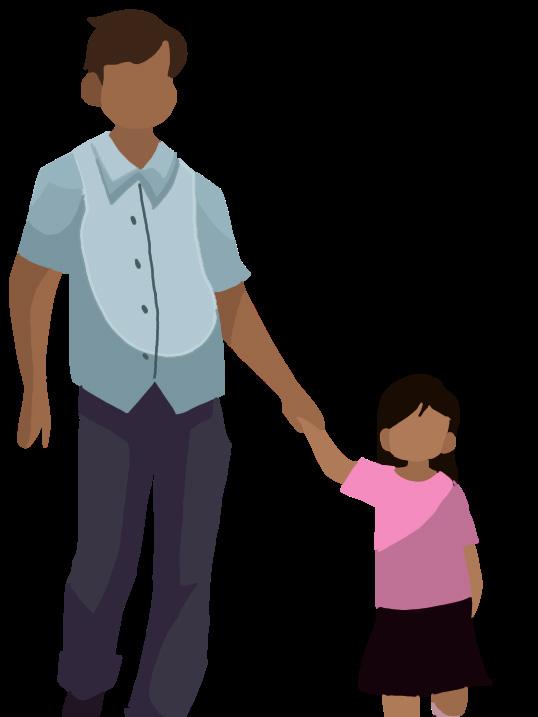 BY GAURI MANOJ
BY GAURI MANOJ
Iwas always the last kid to be picked up from Lincoln Elementary School. I’d go to the after-school YMCA program and try to pass time building Legos or finishing the entire Harry Potter series, my eyes darting towards every parent who walked in, in the hopes that they would be my own.
When my mom or dad finally showed up, usually after 6 p.m., I’d ask them with watering
everything in the world to leave their jobs early and bring me home, but unfortunately, this is just how their lives work.
I was eight when my dad called to tell us he had been laid off from what I called his “fancy computer job.”
While my dad, mom and brother nervously discussed our new pressing financial situation,
I excitedly
find him a new job as a firefighter. That’s the job I always wanted him to have, so he wouldn’t spend all his hours coding and away from me. I knew the firefighters I saw on TV were strong and brave and saved lives — they were real superheroes. My brother, as always, rolled his eyes at me, but my dad just laughed and told me to let him know if any firefighter positions open up in
my dad found work again at Google, my parents didn’t really talk about their fancy
computer jobs. Their everyday lives seemed rather ordinary to me — they drove to work early and sat at laptops for hours. Sometimes I felt angry that they chose to pursue this boring and busy software engineering life over spending time with me.
My parents were not always — sorry, if you two are reading this! — boring. As teenagers in India, they loved to dance and sing when their parents left the house and climb up 20-foot-tall trees to steal the sweeter coconuts from their neighbors. Eventually, when they chose to begin a family, they traded that life and embarked on a new one, one where they instead had to prioritize their salaries over their favorite pastimes.

My parents don’t even enjoy computer science — my mom actually dreamt of becoming a physicist and my dad fell in love with mechanical engineering. But the promised security of the tech industry, especially during an extremely volatile economy in the 2000s, led them to give up their dreams for the sake of their children — a familiar story for many immigrants in the Bay Area.
As I’ve matured, I’ve realized that my parents’ seemingly mundane and busy lifestyle is just a small sliver of the life they’ve been working to build for years, a culmination of the hundreds of sacrifices they’ve made after immigrating to America. They

choose to live this dull life because it means they can later watch their children pursue the lives they once dreamt of living.


I still sometimes reminisce about all the things I watched my friends do with their families — game nights, eating dinner together at the table, watching movies — and I still wish my parents had been around more often when I was younger. But I learned to stop comparing them to the seemingly perfect parents I saw at my friends’ homes or on TV, because their stories and circumstances are so unimaginably different.
Though it took me a while, I’ve grown to understand that my parents’ love has always been interwoven in the invisible sacrifices they made for my brother and me, even if I wasn’t always able to immediately feel their affection. And honestly, maybe it’s not too late to start eating together at the dinner table or playing a quick game of Monopoly every once in a while — just a subtle reminder that our family is definitely not boring.
Obviously, my dad never became a firefighter. But he will still always be one of my favorite superheroes.
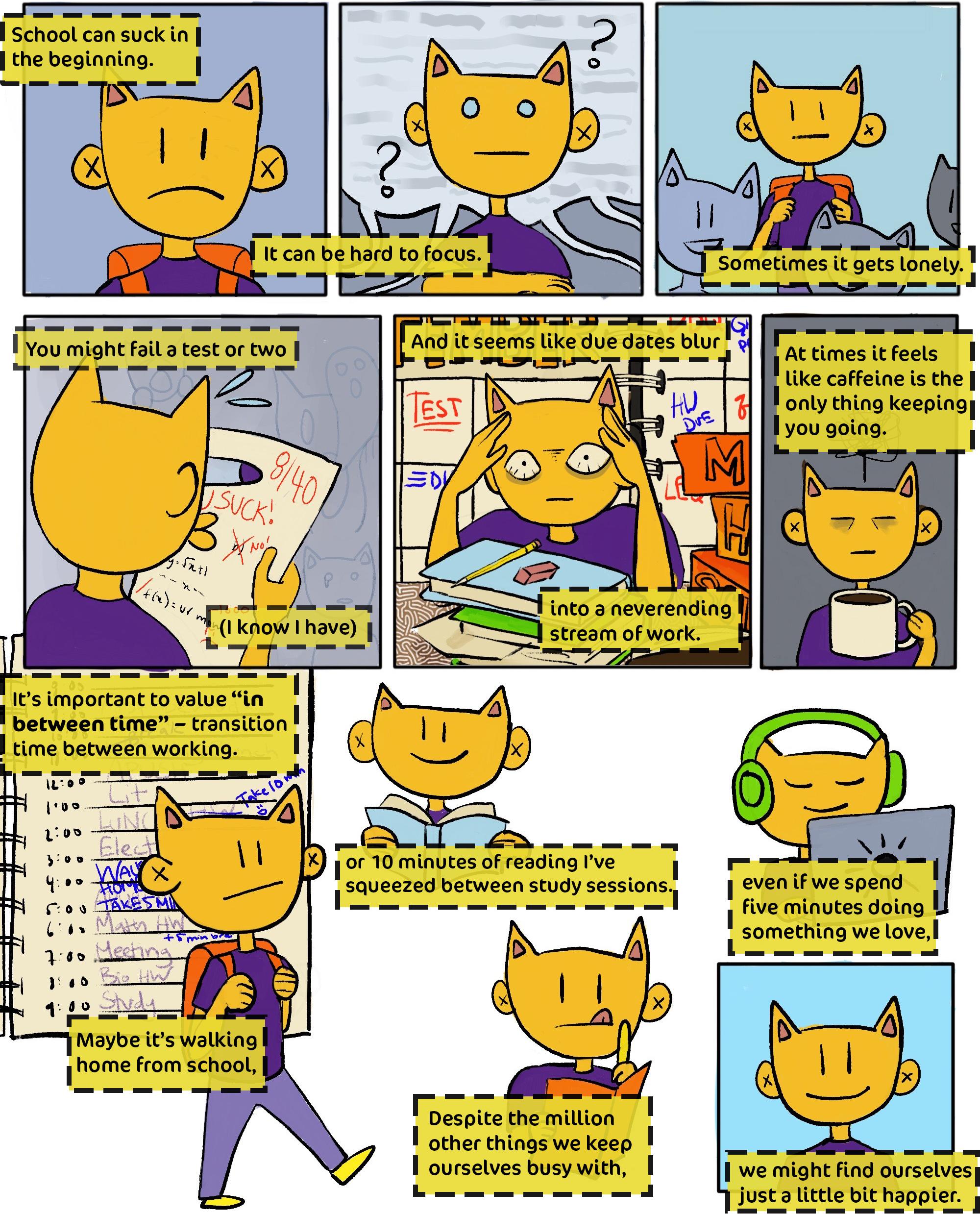 BY SONIA VERMA
BY SONIA VERMA

School is tough, but it’s important to take some time for yourself
BY CHIRAN ARUMUGAM, SAMIKA
BY CHIRAN ARUMUGAM, SAMIKA
BHATKAR, DAHLIA SCHILLING, JIYA SINGH, AASHI VENKAT AND ANABELLE WALKER
BHATKAR, DAHLIA SCHILLING, JIYA SINGH, AASHI VENKAT AND ANABELLE WALKER
Understanding thoughts behind fashion and social media advertising






Most advertised item among members of the community
 BY DAHLIA SCHILLING AND JIYA SINGH
BY DAHLIA SCHILLING AND JIYA SINGH
Literature teacher Derek Lu created his first social media account in the mid 2000s on MySpace before he downloaded Facebook, Instagram and Snapchat.
As an avid fan of Beyoncé, Adele and all things music, Lu is frequently targeted with ads for vinyl records and concert tickets. While Lu is mostly indifferent towards targeted advertisements or the infiltration of sponsorships in the digital age, the increase in influencers on his social media feed is not something he enjoys.

“I mostly view [media influencers]
said.
are part of the culture of social media that’s so toxic — a lot of these influencers
in their looks or popularity, when what they have to say isn’t all that necessarily useful.”
Junior and Principles of Marketing student Samuel Yao, an avid Instagram user, understands the necessity of social media advertising, particularly in attracting young audiences. Still, he feels overwhelmed, especially by political ads that clog up his feed. He shares his immediate response is to skip those advertisements as soon as possible.
“I think in the modern day, at least, social media advertising is probably the most effective way [to influence people],” Yao said.
“The majority of the population has social media, and they’re always scrolling through it. It can be easier to catch someone’s eye through [social media] than TV or newspapers.”
Freshman Pranay Subramanian’s most used social media app is YouTube, though his usage varies depending on his workload. While Subramanian believes kids his age don’t click on sketchy ads, he recognizes that younger kids might be more susceptible to doing so.
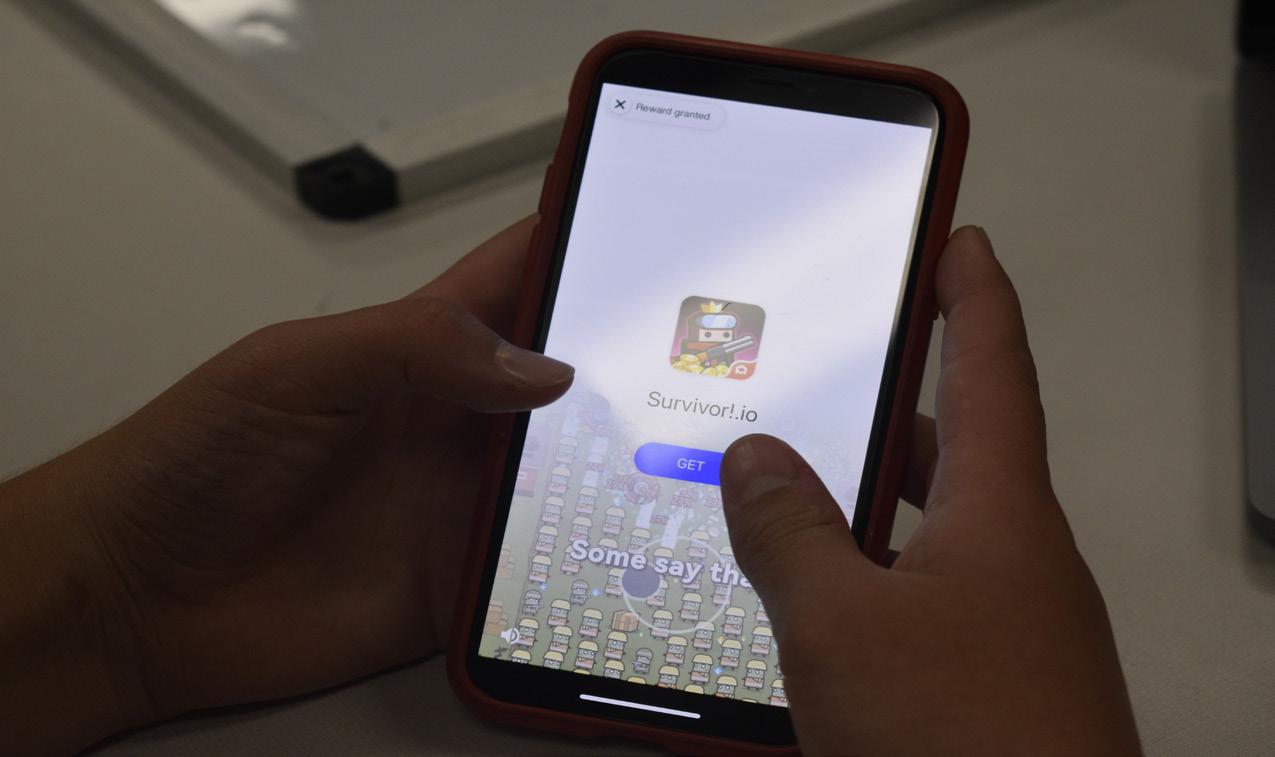
“[At] our age, because we are much older, we understand that [advertisements] are scams,” Subramanian said. “But for younger kids and younger generations, they see a famous person that they like and automatically click. That’s just not very good because more people are falling into that trap.”
Sophomore Aayushi Ayalasomayajula typically spends 30 to 40 minutes on Instagram each day, often getting ads for games, even ones she already has.
“When I see ads of games I already have, I’m like, ‘I literally play that game — it’s different [than advertised],” Ayalasomayajula said. “I think [ads] can be [harmful] if they’re not leading to the place they say they are.”

Senior Aishwarya Samptur faces plenty of targeted clothing ads on Instagram, her primary source of social media. Samptur says the items recommended to her are accurate to her taste, leading her to create a list on her Notes app with more than 50 links to material she has been advertised and wishes to purchase someday. A frequent appearance on this list is the Instagram-sponsored small business “RealTakai,” which Samptur has been following on the company’s social media since seeing a menswear look in an ad.
“I engage with clothing posts and save them if I want to recreate different looks,” Samptur said. “[Targeted advertisements] exposed me to clothing that helped me expand my style more.”

The consequences of corporate resistance to include diverse body types
BY AASHI VENKAT AND ANABELLE WALKERW hile attending St. Louis University in the late 1990s, history teacher Bonnie Belshe received a call from a representative at Liz Claiborne, a popular fashion brand at the time. Belshie believes a classmate’s mom referred her to the representative, who offered Belshe a position as a model for Liz Claiborne’s plus-size clothing line “Elizabeth,” based in St. Louis.
Fashion at the time was, according to Belshe, “all about being as thin as possible,” so Liz Claiborne’s decision to create a series of “plus-size store[s] was huge because [there] were so few options available in plus sizes, and there were so few models representing bodies that were above a size zero.”
Senior Jeremiah Moli believes the fashion industry has progressively
expanded the range of models concerning ethnicity and size. Junior Miriam Law agrees with Moli, attributing brands such as Urban Outfitters, TopShop, Nordstrom and Girlfriend Collective with having diverse model demographic and sizing. However, Law also believes that, despite brands getting more inclusive, there are still areas where the fashion industry can diversify.
“Sometimes brands like Victoria’s Secret — [that] fall into the more intimate side [of clothing] — prefer [specific] models or specific sizes,” Law said. “And that goes against the whole [concept of] diversity.”
Victoria’s Secret is one brand that, according to Law, has failed to incorporate diversity. Due to this lack of diversity being present across many clothing companies, not only is the
selection for clothes much narrower for plus-sized individuals, the clothes also tend to fall behind in trends and, according to Belshe, consistently have an unflattering appearance.
“Some [brands’] plus-size [clothing lines have] absolutely horrendous clothing,” Belshe said. “[There are so many] cold-shoulder shirt[s] for plus size women — you only see these for plus sized women, where it would be [a] jacket [with] just the shoulder [region cut out] — because heaven forbid any other part of our body show.”
Moli also mentions how body positivity has come a long way since the 1990s and early 2000s.
“There’s a trend of inclusivity when it comes to [body positivity, where companies are] getting different models who are of different shapes and sizes [to diversify the representation on their website],” Moli said, attributing brands such as Nike and Puma to being part of this growing trend.
In particular, Law states how the transition into brands representing diverse bodies conveys that being plus-size is just as acceptable as being petitie or mid-sized, and being a person of color is just as acceptable as being white. Law also says that companies who portray both these concepts appeal to a larger audience.

“I feel more comfortable buying the clothes [from companies that include body diversity], especially knowing that they don’t have implied expectations for people who are buying them and consumers in general,” Law said.
“Especially because I don’t fit into that typical white model [that] a lot of websites like to portray. [Having diversity is] a good way of marketing in my opinion.”
However, Moli also states how, despite the industry getting more inclusive in the past decades, “there’s [still] an aspect of favoring a specific type of [models]: the heterocentric, [which is] women are white, [and] typically more fit.” Belshe agrees with Moli, stating how the model demographic for plus-size models
remains “overwhelmingly white, even more so than [for] straight sizes,” which demonstrates how many brands have begun creating an inverse relationship between racial diversity and size inclusivity.
Belshe explains that she believes this is because the post-Civil war period warped society’s perception of plussize Black people, particularly plus-size Black women.
“Part of the stereotype that was created around Black women [after the Civil War] was [the creation of] the mammy figure — an overweight Black woman who is completely desexualized,” Belshe said. “And then there are a lot of other cultural elements for looking at why we don’t have East-Asian and SouthAsian representation. [Then, there’s] the difficulties for plus-size women in those cultures and societies not having access to a lot of the fashion that’s available. And so we see [all these cultural and social differences come together and be] reflected in [the] U.S. fashion [and modeling industries].”
like that aspect is taking away from the expression of fashion and [putting models on display] like they’re zoo animals, to an extent.”
Though the concept of the “model body” has slowly waned throughout the years, Moli and Law believe the industry continues to glamorize skinnier

at best, excluding plus-sizes while continuing to showcase models with smaller sizes — many major corporations forget to incorporate genuine size diversity in their body positivity campaigns.
“Not everyone is going to have [a] body [that fits a size zero],” Belshe said. “And it’s not achievable, nor [is it] healthy for many people [to try]. And I’m not saying [that] someone who [is] thin is unhealthy. But the ways in which many — young women especially — try and go about to achieve that ‘model body’ is incredibly damaging.”
According to Moli, racism is still deeply ingrained in the modeling industry. Moli explains that many corporations include diversity purely to expand their consumership, which Moli explains is counterproductive as it leads to people of color and plussized models being tokenized in the modeling industry.
“[Companies are] using the trend of body inclusivity to sell their brand,” Moli said. “Because they [think if they’re ‘safe’] towards what people are leading to then we can sell more and avoid the controversy of pushing out what people aren’t liking. So I feel like they’re exploiting [the social movement]. And perhaps even exploiting people just [for diversity] ... it’s like, ‘Oh, they’re exotic!’ and I feel
“What they call ‘plus size model’ is not even into midsize[s],” Belshe said. “[Brands] don’t always do plus sizes correctly — you can’t just size up You can’t just make it all longer and wider. [For example], if you have to double the size of the chest of a shirt, you [can’t] also double the size of a wrist. You have to think about the proportions for [sizing]. A lot of brands have tried and failed [to expand their sizing] because they are unwilling to put the research into [broadening size ranges] and [they are] unwilling to see what the clothes look like on actual fat bodies.”
According to Belshe, the overrepresentation of predominantly skinny models on fashion websites is particularly dangerous for younger, more impressionable individuals.
This fall, as the field hockey season approached, senior and captain Lauren McMillion looked forward to finally getting a chance to participate in planning how the team would decorate its team room, a tradition that seniors partake in.

McMillion says despite the seniors being the only ones decorating the room, the yearly tradition helps to bridge the gap between both old and new members of the team.
“It’s a way to show them how the

team works together and also opens up conversation,” McMillion said.
The seniors decided on the theme and decorations, then placed orders on Amazon and bought items from both Party City and Dollar Tree. Throughout a two-day decorating process, the seniors managed to transform their team room into an outer space theme.

In order to make the room more “comfortable and welcoming,” McMillion and the other seniors
brought items such as snacks, extra clothes and sanitary products. She also adds that while the seniors have the responsibility of maintaining the team room, each person has the individual responsibility of bringing a lock and making sure to lock their locker. Otherwise, McMillion adds that “[the] coach gets upset, and [may take] the team room away from [the team].”
Although Cheer captain Sanika Kothari understands the necessity of the team room for other teams, she wishes that
Senior Aashna Patel adds a star to the wall of field hockey‘s space-themed team room.Cheer could have a chance to use one of the team rooms or the old dance room. Last year, Cheer moved all of its equipment into the old dance room, but due to other sports also using the room for storage, the team found a large portion of their equipment misplaced or lost.
“We were confused as to where we could keep our stuff [and] where we could store uniforms [or] anything extra that we had,” Kothari said. “So having a team room would definitely eliminate that feeling and make us feel a lot more secure.”
room would certainly help Cheer keep track of all of the gear they use, she also believes the team room could double as a space to get ready before a game for all members of the team.
McMillion understands that having a team room is a privilege, as Athletic Director Nick Bonacorsi explains there are only four team rooms available at MVHS.

While the fall season hosts eight different sports, the four team rooms are occupied primarily by three sports. The football team uses the front two team rooms, while the field hockey team, sometimes joined by Girls Tennis, uses the back two team rooms.


When deciding which teams are able to use the rooms, Bon acorsi believes it mostly comes down to the amount of equipment each sport requires.
“Football probably has the most overall equipment between all the pads and stuff that they wear,” Bonacorsi said. “Field hockey has always used them because [their] bags tend to be on the larger side.”


While Kothari says a team
“If we go into bathrooms to get ready, not everybody can go into the same bathroom, so it makes it hard to have a full team bonding a lot of the time,” Kothari said. “So if we had a room where we could get ready for events, it would make it easier because everybody could be in the same room and we can all be together.”
While the current team room system isn’t perfect, McMillion believes the room provides an environment where members can set aside the stress accumulated throughout the day and divert their attention to field hockey.

“The [team] room provides a safe place for players,” McMillion said. “It gets chaotic, [but] conversations talking about whatever happened [during the school day] bounce off the walls, allowing space for laughter
For the football team, the team room is used as a set place to review plays.
Senior Alexander Lee says that especially before games, he takes advantage of the room to ask other players clarifying questions about specific plays. In spite of not decorating its team room, Lee believes that the team rooms provide the players with a sense of security, as the rooms also serve as a safe space for them to bond with each other before and after both practices and games.
While the team room can serve as a serious space for game planning, it also serves as a space where all members can support each other.
“[The team room] gives an environment where everybody’s open with each other, like a family,” Lee said.
‘‘PHOTO | AIDAN RUAN
 BY GAURI MANOJ AND VINCENT ZHAO
BY GAURI MANOJ AND VINCENT ZHAO
6Junior Sohni Tagirisa, right defender for the field hockey team, draws inspiration for her number six from many sources. She first started wearing this number when she was a young soccer player. When choosing her number, she chose six to pair with her friend who chose five because of an Indian dish called Chicken 65. She now feels as though she has a field identity as she has been called the number six throughout her field hockey career.

“My field identity [makes me] feel more aware of the way I feel,” Tagirisa said. “[It] feels more like a adaptable version of me that also has a close knit bond with my team.”


In Japanese culture, the number four — 四 — is often avoided due to its similarity with the Japanese word for “death.” With this superstition in mind, senior and Boys Basketball point guard Austin Hwang chose the number four to help himself unlearn the negative connotations of the number, teaching him to appreciate his opportunities rather than fear death.
“I think it’s a core reminder that eventually things have to come to an end,” Hwang said. “There are definitely moments in the past where I wish I could have said more to someone who passed away. I felt like it was always weird that you have to say all these wonderful things about how great of a person or how much they meant to you after [they die], so you should say it now before it’s too late.”

Sophomore middle on the Girls Volleyball team Lisa Smith gets inspiration for her jersey number from her sister. In middle school, her sister, Kate Smith, started to play volleyball as number 11 because her birthday is May 11. Before this year, Smith wore number 26 for her own birthday, but this year she switched to number 11, to honor her sister after she went to college.



Having [my sister’s] number makes her feel close to me since she’s far away,” Smith said. “ [I] just miss hanging out with her and talking about life.”
When junior and quarterback Rohit Pamidi joined the Football team his freshman year, MVHS alum ‘21 and former quarterback Simon Loeffler became his mentor. The lack of in-person practices during remote learning motivated Loeffler to invite the players to the park or an open football field outside of school to hone their plays and routes. When Pamidi returned to the team sophomore year, he chose to be number five as a tribute to Loeffler’s old jersey number.

“I decided to pick number five because of how much [Loeffler] taught us and what he did for me and my friends,” Pamidi said. “After picking my number, five became my favorite number.”
 PHOTO
PHOTO
The entire locker room was buzzing, more alive than normal.
Initially, senior Kinton Duong credited it to the sounds — the loud, thumping music and shouts of the players surrounding him. The unusual
sights contributed too, with his teammates, including himself, dressed in nothing but their speedos, shoes and an occasional ski mask. But really, it was the adrenaline — the building anticipation of the players as they prepared to run.
Each year, at the end of the senior class Homecoming skit, the Boys Water Polo players run a lap around the rally court in their speedos. Dubbed the “Water Polo Speedo Run,” Duong says that it has become a cherished homecoming tradition for the team, with the locker room preparation for the speedo run being only a sliver of the team bonding that the annual tradition brings.
In 2021, the speedo run evolved to include the girls water polo team for the first time. According to senior Maya Mizrahi, the team was excited to be included in the tradition. The administration had also initiated a separate rule where anyone who participated was required to wear shorts during the run, which Mizarahi says garnered feelings of “frustration from [the] teams.”

“I enjoyed the fact that they included the girl’s team because I think it made both teams bond together,” Mizrahi said. “But the fact that they wouldn’t let us wear our usual swimsuits, even though we wear those every single day to games and people on campus see us in them frequently was a little disappointing. It made it less traditional.”
While Duong acknowledges how the run could be potentially inappropriate and entail restrictions, he also feels the experience of the tradition is dampened by the change. However, Principal Ben Clausnitzer supports the initiation of the change beleiving that players should celebrate the traditions in the appropriate attire for their environment.
“We want people to engage in spirit and have fun [in a way] where they don’t actually wear their uniforms,” Clausnitzer said. “The uniforms aren’t always a fit for a different place.”

On the other hand, Mizrahi expresses that there is a need to

effect on students but still encourages unity across different teams.
normalize the players’ uniforms, believing that students regularly see the players in uniform at any time during games and that the run is no different. Instead, she feels the uniforms contribute to the authenticity of the tradition, making the run more iconic.
“It’s important that we don’t try to censor something that’s natural, like us being in our swimsuits,” Mizrahi said. “We shouldn’t try to shame our students just for their bodies and how they look in a swimsuit. [The speedo run] is a longstanding tradition and it’s not really a surprise to anyone that it’s gonna happen.”

“I think there’s a time and place for everything and we want students to be spirited,” Clausnitzer said. “I wish we could find an actual school event, one that’s schoolsponsored, that could honor and celebrate their work in a way that’s more constructive and doesn’t distract


from all the amazing things they do in the pool.”
believe the water polo speedo run is not inappropriate
*according


Clausnitzer also points out the exclusive nature of the event and wants to address the need for a wider conversation around the tradition. He says that ideally, the tradition would be reconstructed to become an experience that is less independent from spectators.
“What we have tried to do over time as a school is try to open those communications with the students to say that it isn’t something that’s a school activity [and] it’s not something that we would recommend,” Clausnitzer said. “But if a group of people [want to] do something, you ought to at least do it in a way that is as inclusive as it can be.”
Clausnitzer applauds the effort of team spirit by water polo and other sports teams, but hopes for a more united approach to these traditions. He strives to find a new form of team festivity that minimizes the
do not believe the tradition should be changed.
*according
IT’S IMPORTANT THAT WE DON’T TRY TO CENSOR SOMETHING THAT’S NATURAL, LIKE US BEING IN OUR SWIMSUITS.
Taking a look at the fall sports season



 BY KALYANI PUTHENPURAYIL
BY KALYANI PUTHENPURAYIL
Freshman Jillian Wang gets ready to serve the ball during the team’s game against Mountain View High School on Sept. 27. The teams were neck-and-neck until freshman Leilani Laruelle broke the tie with her match and the Matadors won 4-3.

Sophomore Jooha Kim performs during the Football team’s second home game. The Cheer team performed throughout the game to raise the spectators’ spirit and had a show during halftime in which they performed several stunts.


Senior Ethan Tarng looks to make a pass during the Boys Water Polo game against Saratoga High School. During the game, MVHS stayed in the lead throughout all four quarters and won 16-10.

Seniors Miranda Shakouri and Sydney Su jump to block the ball during the Girls Volleyball game against Mountain View High School, which the team lost 3-2. The team currently has a league record of 1- 2 and is fifth out of the seven teams in the De Anza League.







